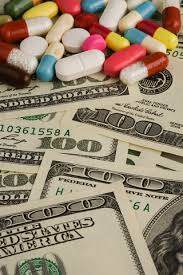July 17th, 2011 by David Kroll, Ph.D. in Opinion, Research
No Comments »

So, you’re curious about herbal medicine. Is there any truth to this stuff?
Uncle Howie tells you that he read in the National Enquirer about an herb that has better antibacterial effects on cuts and scrapes than Neosporin ointment — never mind that Neosporin is composed of three different antibiotics that come originally from bacteria themselves.
So you set out on a quest to purchase some of this herb, known colloquially as goldenseal. When you go to your local Whole Hippie Dump-a-Load-of-Cash Emporium you find goldenseal alright, in about twenty different forms. On one side of the aisle are containers with loose, crushed up leaves and roots that look like medical marijuana. On a shelf, you find see-through capsules that seem to contain a powdered version of the herb. Down the aisle a bit you find boxes of blister-packs containing a proprietary extract of free-range goldenseal from the Appalachians harvested under moonlight by bare-breasted virgins. The same company also makes an ointment, allegedly procured the same way.
A scraggly young man with a rainbow-colored Whole Hippie tam comes by and says, “Dude, can I help you?” As you wave away the cloud of patchouli oil and three days of body odor, you ask him, “So, this goldenseal — which one should I buy?”
Hippie Boy looks both ways down the aisle and motions with his finger to come close.
“Dude, all this expensive stuff is just a ploy by The Man trying to make a buck with their fancy scientific words and processes. What you want is the whole herb, man — the stuff given to us by the sprites and spirits. Those capsules miss the point. Part of the magic is missing. You pay extra to get less.”
“But, dude,” you say. “I want to try the ointment, you know, for cuts and scrapes. How do I use this herb?”
The fine young man then explains how to make a poultice, an old-fashioned decoction of plant material that one wraps on a cut — sort of like collard greens.
This really seems like more trouble than it’s worth. You’re about a millisecond away from just heading down to the Done-Rite Drugs, Liquor, and Tobacco to buy a simple tube of Neosporin. But hey, it’s an experiment and you’re curious.
While you’re checking out from the health food store, a local scientist friend is in line at the next register, checking out your stash of goldenseal.
“You know, you should really go read Science-Based Medicine to get the straight dope on that stuff.”
And so, here you are. And I’m here for you.
[Note to readers: Apologies to my hippie friends. I love you all. No hippies were harmed in the drafting of this blogpost.]
Is there any scientific evidence to support a common herbalist claim that whole plant materials are “better” than semi-purified extracts or pure, individual chemicals made by the plant? Read more »
*This blog post was originally published at Science-Based Medicine*
March 30th, 2011 by Harriet Hall, M.D. in Opinion, Quackery Exposed
1 Comment »

David Kroll’s recent article on thunder god vine is a great example of what can be learned by using science to study plants identified by herbalists as therapeutic. The herbalists’ arsenal can be a rich source of potential knowledge. But Kroll’s article is also a reminder that blindly trusting herbalists’ recommendations for treatment can be risky.
Herbal medicine has always fascinated me. How did early humans determine which plants worked? They had no record-keeping, no scientific methods, only trial and error and word of mouth. How many intrepid investigators poisoned themselves and died in the quest? Imagine yourself in the jungle: which plants would you be willing to try? How would you decide whether to use the leaf or the root? How would you decide whether to chew the raw leaf or brew an infusion? It is truly remarkable that our forbears were able to identify useful natural medicines and pass the knowledge down to us.
It is equally remarkable that modern humans with all the advantages of science are willing to put useless and potentially dangerous plant products into their bodies based on nothing better than prescientific hearsay. Read more »
*This blog post was originally published at Science-Based Medicine*
March 8th, 2011 by ErikDavis in Opinion, Quackery Exposed
1 Comment »
 This is a guest post from Erik Davis of Skeptic North.
This is a guest post from Erik Davis of Skeptic North.
**********
Bankers, Buyouts & Billionaires: Why Big Herba’s Research Deficit Isn’t About The Money
It’s a scene from the blogosphere that’s become all too familiar. A skeptic challenges a natural health product for the lack of an evidentiary base. A proponent of that product responds that the skeptic has made a logical error — an absence of evidence is not evidence of absence, and in such a scenario it’s not unreasonable to rely on patient reporting and traditional uses as a guide. The skeptic chimes back with a dissertation on the limits of anecdotal evidence and arguments from antiquity — especially when the corresponding pharma products have a data trail supporting their safety and efficacy. The proponent responds that it’s unfair to hold natural health products to the same evidentiary standard, because only pharma has the money to fund proper research, and they only do so for products they can patent. You can’t patent nature, so no research into natural health products gets done.
Okay, so maybe this isn’t a scene from an actual blog. The participants are way too civil, the arguments too coherent, and no one has been compared to Hitler. But it’s not a straw man either (look here, here, and here for recent examples), merely a distillation of an argument I’ve seen made repeatedly — that the deck has been stacked by Big Pharma, which has set a research bar that the much poorer natural health industry can’t possibly meet given the costs and lack of financial upside.
In my observation, skeptics don’t often have a good response to this argument beyond their basic scientific disposition toward only making assertions based on positive evidence. Typically, that’s not a disposition shared by the proponent, and thus they simply agree to disagree (read: trade barbs until the thread peters out from fatigue). Yet this need not be a purely philosophical debate. After all, there’s a testable premise embedded in this disagreement — that the natural health industry isn’t rich enough to sustain proper research. Is that true? Read more »
February 24th, 2011 by Harriet Hall, M.D. in Health Tips, Research
1 Comment »

I was surprised to get this e-mail from a reader:
Surely, Dr. Hall, the public mania for nutritional supplements is baseless. All the alleged nutrients in supplements are contained in the food we eat. And what governmental agency has oversight responsibility regarding the production of these so-call nutritional supplements? Even if one believes that such pills have value, how can the consumer be assured that the product actually contains what the label signifies? I have yet to find a comment on this subject on your otherwise informative website.
My co-bloggers and I have addressed these issues repeatedly.Peter Lipson covered DSHEA (The Diet Supplement Health and Education Act) nicely. It’s all been said before, but perhaps it needs to be said again — and maybe by writing this post I can make it easier for new readers to find the information.
Food, Medicine, or Something In Between?
The FDA regulates foods and has been instrumental in improving the safety of our food supply. It regulates prescription and over-the-counter medications, requiring evidence of effectiveness and safety before marketing. Surveys have shown that most people falsely assume these protections extend to everything on the shelves including diet supplements, but they don’t.
Under the 1994 Diet Supplement Health and Education Act (DSHEA), a variety of products such as vitamins, minerals, herbs and botanicals, amino acids, enzymes, organ tissues, and hormones can evade the usual controls if they are sold as diet supplements. Under the DSHEA, the manufacturer doesn’t have to prove to the FDA that a product is safe and effective; it is up to the FDA to prove that it isn’t safe, and until recently there was no systematic method of reporting adverse effects (required reporting is still limited to serious effects like death).
So far the FDA has only managed to ban one substance, ephedra, and it took the death of a prominent sports figure and considerable skirmishing with the courts to accomplish that. Independent lab tests of diet supplements have found a high rate of contamination (with things like heavy metals and prescription drugs) and dosages wildly varying from the label. A striking example was Gary Null’s recent poisoning with vitamin D from one of his own products which contained 1,000 times the intended amount.
The FDA has issued rules on good manufacturing practices, but standardization is not required and it remains to be seen whether the new rules will effectively improve product quality. Read more »
*This blog post was originally published at Science-Based Medicine*
October 20th, 2010 by DrCharles in Better Health Network, Health Tips, Opinion, Research
No Comments »

 What is in a prenatal vitamin? Why do most doctors recommend them? Is there any evidence taking them is worthwhile? I decided recently that I would read through the ingredients of these vitamins, often touted as “essential vitamins and nutrients, crucial for the healthy development of your baby.” Hmmm. Does that mean eating traces of polyvinyl alcohol every day is beneficial?
What is in a prenatal vitamin? Why do most doctors recommend them? Is there any evidence taking them is worthwhile? I decided recently that I would read through the ingredients of these vitamins, often touted as “essential vitamins and nutrients, crucial for the healthy development of your baby.” Hmmm. Does that mean eating traces of polyvinyl alcohol every day is beneficial?
The fine print ingredients of such brands as “One A Day”, “Centrum Materna”, “Rite Aid” and even the prescription only “Prenate Elite” are a confusing mess of milligrams, international units, RDA’s, and chemicals. As the makers of Centrum explain, “It is very challenging to formulate vitamins and minerals without the use of non-medicinal ingredients which serve to keep the product stable and to prevent the various ingredients from interacting.” They also find fault in the limited number of suppliers of the active ingredients in prenatal vitamins, and therefore claim substances like gelatin are difficult to avoid.
Let’s take a tour of the prenatal vitamin ingredient zoo. Read more »
*This blog post was originally published at The Examining Room of Dr. Charles*













